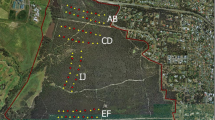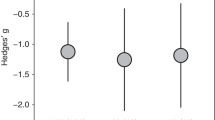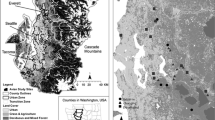Abstract
We report on the extent of disturbance (including habitat alteration and road and trail proliferation) in chaparral near urban development and analyze the effects of disturbance on small mammal and resident bird species. Disturbance patterns were evaluated in a 6700 ha study area in southern California: effects on mammals and birds were investigated by analyzing relationships between vegetation structure and animal species richness and abundance. Disturbance was prevalent throughout the study area and included extensive human-altered habitat (from past human activities such as vegetation clearing, human-caused fires, refuse dumping, and vegetation trampling) and 157 km of roads and trails. A nonsignificant trend was found between human-altered habitat and proximity to development, but human-altered habitat was significantly associated with roadway proximity. Trails were also more frequent near urban development and roads. Small mammals responded strongly to disturbance-related vegetation changes, while birds showed little or no response. Mammals endemic to chaparral vegetation were less diverse and abundant in disturbed sites, whereas disturbance-associated species increased in abundance. Close proximity of urban development to natural areas resulted in alteration of natural habitat and proliferation of roads and trails. Variation in life history traits between birds and mammals may affect response to disturbance and influence persistence if disturbance continues. Conservation efforts must recognize the potential for habitat damage and associated declines in native animal species caused by disturbance near urbanization and implement strategies to reduce these threats.
Similar content being viewed by others
References
American Ornithologists' Union (AOU) (1998) Check-list of North American birds. 7th ed. Allen Press, Lawrence, KS.
Blair, R. B. (1996) Land use and avian species diversity along an urban gradient. Ecol. Appl. 6, 506-519.
Bolger, D. T., Alberts, A. C., Sauvajot, R. M., Potenza, P., McCalvin, C., Tran, D., Mazzoni, S. and Soulé, M. E. (1997a) Response of rodents to habitat fragmentation in coastal southern California. Ecol. Appl. 7, 552-563.
Bolger, D. T., Scott, T. A. and Rotenberry, J. T. (1997b) Breeding bird abundance in an urbanizing landscape in coastal southern California. Conserv. Biol. 11, 406-421.
Boyle, S. A. and Samson, F. B. (1985) Effects of non-consumptive recreation on wildlife: a review. Wildl. Soc. Bull. 13, 110-116.
Brittingham, M. C. and Temple, S. A. (1983) Have cowbirds caused forest songbirds to decline? BioScience 33, 31-35.
Buechner, M. (1987) Conservation in insular parks: simulation models of factors affecting the movement of animals across park boundaries. Biol. Conserv. 41, 57-76.
Buechner, M. and Sauvajot, R. M. (1996) Conservation and zones of human activity: the spread of human disturbance across a protected landscape. In Biodiversity in Managed Landscapes: Theory and Practice (R. C. Szaro and D. W. Johnston, eds), pp. 605-629. Oxford University Press, New York.
Chen, J., Franklin, J. F. and Spies, T. A. (1993) Contrasting microclimates among clearcut, edge, and interior of old-growth Douglas-fir forest. Agricultural and Forest Meteorology 63, 219-237.
Cody M.L. (1981) Habitat selection in birds: the roles of vegetation structure, competitors and productivity. BioScience 31, 107-111.
Davis, D. D., ed. (1982) CRC Handbook of Census Methods for Terrestrial Vertebrates. CRC Press, Boca Raton, FL.
Dawson, K. J. (1996) Interior and exterior land use as factors in landscape biodiverisity from case studies. In Biodiversity in Managed Landscapes: Theory and Practice (R. C. Szaro and D. W. Johnston, eds), pp. 514-530. Oxford University Press, New York.
Dickman, C. R. and Doncaster, C. P. (1987) The ecology of small mammals in urban habitats. I. Populations in a patchy environment. J. Anim. Ecol. 56, 629-640.
Dickman, C. R. and Doncaster, C. P. (1989) The ecology of small mammals in urban habitats. II. Demography and dispersal. J. Anim. Ecol. 58, 119-127.
Doak, D. F. (1995) Source-sink models and the problem of habitat degradation: general models and applications to the Yellowstone grizzly. Conserv. Biol. 9, 1370-1379.
Dobson, A. P., Rodriguez, J. P., Roberts, W. M. and Wilcove, D. S. (1997) Geographic distribution of endangered species in the United States. Science 275, 550-553.
Ehrlich, P. R., Dobkin, D. S. and Wheye, D. (1988) The Birder's Handbook. Simon and Schuster, New York.
Emlen, J. T. (1971) Population densities of birds derived from transect counts. Auk 88, 323-342.
Environmental Systems Research Institute, Inc. (1995) Arc/Info. Revision 7.0.3. Redlands, CA.
Friesen, L. E., Eagles, P. F. J. and MacKay, R. J. (1995) Effects of residential development on forest-dwelling neotropical migrant songbirds. Conserv. Biol. 9, 408-1414.
Garrett, K. and Dunn, J. (1981) Birds of Southern California: Status and Distribution. Los Angeles Audubon Society, Los Angeles, CA.
Gates, J. E. and Gysel, L. W. (1978). Avian nest dispersion and fledging success in field-forest ecotones. Ecology 59, 871-883.
Hannah, L., Lohse, D., Hatchinson, C., Carr, J. L. and Lankerani, A. (1994) A preliminary inventory of human disturbance of world ecosystems. Ambio 23, 246-250.
Hannah, L., Carr, J. L. and Lankerani, A. (1995) Human disturbance and natural habitat: a biome level analysis of a global data set. Biodiv. Conserv. 4, 128-155.
Harris, L. D. (1988) Edge effects and conservation of biotic diversity. Conserv. Biol. 2, 330-332.
Heady, H. F., Gibbens, R. P. and Powell, R. W. (1959) A comparison of the charting, line intercept, and line point methods of sampling shrub types of vegetation. J. Range Manage. 12, 180-188.
Holm, S. (1979) A simple sequentially rejective multiple test procedure. Scand. J. Stat. 6, 65-70.
Howe, R. W., Davis, G. J. and Mosca, V. (1991) The demographic significance of “sink” populations. Biol. Conserv. 57, 239-255.
Hutto, R. L. (1989) The effect of habitat alteration on migratory land birds in a west Mexican tropical deciduous forest: a conservation perspective. Conserv. Biol. 3, 138-148.
Jameson, E. W., Jr. and Peeters, H. J. (1988) California Mammals. University of California Press, Berkeley, CA.
Janzen, D. H. (1986) The eternal external threat. In Conservation Biology: The Science of Scarcity and Diversity (M. E. Soulé, ed.), pp. 286-303. Sinauer Associates, Sunderland, MA.
Jim, C. Y. (1989) Visitor management in recreation areas. Environ. Conserv. 16, 19-32, 40.
Jullien, M. and Thiollay, J. (1996) Effects of rain forest disturbance and fragmentation: comparative changes of the raptor community along natural and human-made gradients in French Guiana. J. Biogeog. 23, 7-25.
Keeley, J. E., ed. (1993) Interface Between Ecology and Land Development in California. Southern California Academy of Sciences, Los Angeles, CA.
Lovejoy, T. E., Bierregaard, R. O., Jr., Rylands, A. B., Malcolm, J. R., Quintela, C. E., Harper, L. H., Brown, K. S., Jr., Powell, A. H., Powell, G. V. N., Schubart, H. O. R. and Hays, M. B. (1986) Edge and other effects of isolation on Amazon forest fragments. In Conservation Biology: The Science of Scarcity and Diversity (M. E. Soulé, ed.), pp. 257-285. Sinauer Associates, Sunderland, MA.
Lubchenco, J., Olson, A. M., Brubaker, L. B., Carpenter, S. R., Holland, M. M., Hubbell, S. P., Levin, S. A., MacMahon, J. A., Matson, P. A., Melillo, J. M., Mooney, H. A., Peterson, C. H., Pulliam, H. R., Real, L. A., Regal, P. J. and Risser, P. G. (1991) The sustainable biosphere research initiative: an ecological research agenda. Ecology 72, 371-412.
MacArthur, R. H. and MacArthur, J. W. (1961) On bird species diversity. Ecology 42, 594-598.
MacDonald, I. A. W., Graber, D. M., DeBenedetti, S., Groves, R. H. and Fuentes, E. R. (1988) Introduced species in nature reserves in Mediterranean-type climatic regions of the world. Biol. Conserv. 44, 37-66.
Matson, P. (1990) The use of urban gradients in ecological studies. Ecology 71, 1231.
Miller, R. G., Jr. (1966) Simultaneous Statistical Inference. McGraw-Hill, New York.
Mills, L. S. 1995. Edge effects and isolation: red-backed voles on forest remnants. Conserv. Biol. 9, 395-403.
Murcia, C. (1995) Edge effects in fragmented forests: implications for conservation. Trends Ecol. Evol. 10, 58-62.
Murphy, D. D. (1988) Challenges to biological diversity in urban areas. In Biodiversity (E. O. Wilson, ed.), pp. 71-76. National Academy Press, Washington, DC.
Noss, R. F. (1987) Protecting natural areas in fragmented landscapes. Nat. Areas J. 7, 2-13.
Paton, P. W. (1994) The effect of edge on avian nest success: how strong is the evidence? Conserv. Biol. 8, 17-26.
Pulliam, H. R. (1988) Sources, sinks, and population regulation. Am. Nat. 132, 652-661.
Quinn, R. D. (1990) Habitat Preferences and Distribution of Mammals in California Chaparral. USDAForest Service, Pacific Southwest Research Station, Berkeley, CA.
Rice, W. R. (1989) Analyzing tables of statistical tests.Evolution 43, 223-225.
Riffell, S. K., Gutzwiller, K. J. and Anderson, S. H. (1996) Does repeated human intrusion cause cumulative declines in avian richness and abundance? Ecol. Appl. 6, 492-505.
Saunders, D. A., Hobbs, R. J. and Margules, C. R. (1991) Biological consequences of ecosystem fragmentation: a review. Conserv. Biol. 5, 18-32.
Sauvajot, R. M. (1995) Conservation science in fire-prone natural areas. In Brushfires in California: Ecology and Resource Management (J. E. Keeley and T. Scott, eds), pp. 11-19. International Association of Wildland Fire, Fairfield, WA.
Sauvajot, R. M. (1997) Edge effects, urban encroachment, and anthropogenic disturbance in southern California chaparral mammal and bird communities. Ph.D. diss., University of California, Davis, CA.
Sauvajot, R. M. and Buechner, M. (1993) Effects of urban encroachment on wildlife in the Santa Monica Mountains. In Interface Between Ecology and Land Development in California (J. E. Keeley, ed.), pp. 171-180. Southern California Academy of Sciences, Los Angeles, CA.
Schonewald-Cox, C. M. (1988) Boundaries in the protection of nature reserves. BioScience 38, 480-486.
Schonewald-Cox, C. M. and Bayless, J. W. (1986) The boundary model: a geographical analysis of design and conservation of nature reserves. Biol. Conserv. 38, 305-322.
Schonewald-Cox, C. M. and Buechner, M. (1992) Park protection and public roads. In Conservation Biology: TheTheory and Practice of Nature Conservation, Preservation and Management (P. L. Fiedler and S. Jain, eds), pp. 373-396. Chapman and Hall, New York.
Scott, T. (1995) California's fragmented shrublands-overview and goals. In Brushfires in California: Ecology and Resource Management (J. E. Keeley and T. Scott, eds), pp. 3-10. International Association of Wildland Fire, Fairfield, WA.
Sieving, K. E. (1992) Nest predation and differential insular extinction among selected forest birds of central Panama. Ecology 73, 2310-2328.
Soulé, M. E., Bolger, D. T., Alberts, A. C., Sauvajot, R. M., Wright, J., Sorice, M. and Hill, S. (1988) Reconstructed dynamics of rapid extinctions of chaparral-requiring birds in urban habitat islands. Conserv. Biol. 2, 75-92.
Soulé, M. E., Alberts, A. C. and Bolger, D. T. (1992) The effects of habitat fragmentation on chaparral plants and vertebrates. Oikos 63, 39-47.
Stephenson, P. J. (1993) The small mammal fauna of Réserve Spéciale d'Analamazaotra, Madagascar: the effects of human disturbance on endemic species diversity. Biodiv. Conserv. 2, 603-615.
Wilcove, D. S. (1985) Nest predation in forest tracts and the decline of migratory songbirds. Ecology 66, 1211-1214.
Zar, J. H. (1984) Biostatistical Analysis. Prentice-Hall, Englewood Cliffs, NJ.
Author information
Authors and Affiliations
Rights and permissions
About this article
Cite this article
Sauvajot, R.M., Buechner, M., Kamradt, D.A. et al. Patterns of human disturbance and response by small mammals and birds in chaparral near urban development. Urban Ecosystems 2, 279–297 (1998). https://doi.org/10.1023/A:1009588723665
Issue Date:
DOI: https://doi.org/10.1023/A:1009588723665




